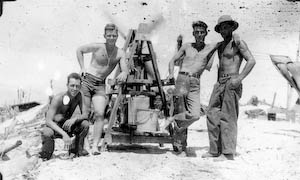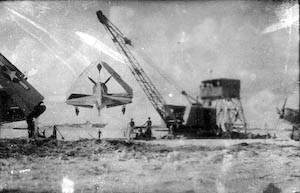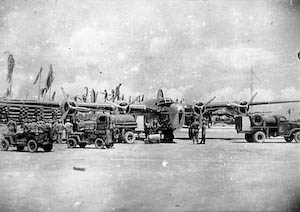With their facilities set up and the field ready for aircraft, the first planes come in. Whether they come in as operating squadrons, or whether carriers come in and unload preserved aircraft depends of course upon what the primary function of that particular air strip and CASU may be.
Sometimes the details in setting up operations on an air strip prove to be rough. Of course, none of the personnel expect to find a bed of roses at the end of their jaunt overseas, but sometimes they find more than they expected.
To cite one particular instance, we’ll line up with a CASU going overseas to a new base. While the number of this CASU cannot be given, it will have to be called just CASU “X”.
Completing its hand to hand combat indoctrination training period with flying colors, CASU “X” was embarked for overseas duty looking more like the Army’s Commandos than a group of aviation technicians.
 Their period of training together on aircraft work had been cut short in the States, so they had been assured that they would learn all about a CASU in operation on an air strip at a base in a rear area, called a staging area. However, when this staging area was reached, they found that there was no room for them to operate there.
Their period of training together on aircraft work had been cut short in the States, so they had been assured that they would learn all about a CASU in operation on an air strip at a base in a rear area, called a staging area. However, when this staging area was reached, they found that there was no room for them to operate there.
Moving on up the line, they were deposited in the Admiralty Islands, which at that time was considered a forward area.
Leaving the ship and coming on the beach, they discovered an island that had been so recently occupied by the enemy that it seemed to have a Japanese atmosphere.
Trucks loaded with coral kept running back and forth the Sea Bees had already arrived and had the coral landing strip well underway.
When shown the area in which they were to live, they made the grave discovery that the area was barren of anything but coconut trees and coral sand.
Undaunted,, the CASU obtained tents from the Acorn and proceeded to set up camp. When all the shelters were up and the men had their gear stowed, it was very close to chow time.
When the call of “When do we eat” made the rounds, the Supply Officer himself piped chow-down with a truck load of “K” rations. There was no mess hall or even a sign of one growing up among the palm trees.
With their first “square” meal in the Admiralties over square, as in a box the CASU turned to with the Acorn in unloading supplies from the ships, and in the setting up of a more sturdy camp.
Other men of the unit went to work with the Sea Bees in building the air strip. This was the choice job among the CASU personnel the Sea Bees had chow, real chow, and it wasn’t dried up and in a box.
With the air strip completed, the first aircraft arrived. The various departments had trouble lining up enough tools and equipment, but this they did quickly and the work began.
First they handled a squadron of planes that a PATSU would have handled if a PATSU had been around Lockheed PV Ventures. It was new work for carrier plane trained boys but they came through very well.
Then the aircraft descended upon the air strip by the hundreds. Fighters, bombers, torpedo planes they were all there. They came in with ferry pilots and they came in on Jeep carriers.
De-preservation work began and the check crews became more than busy. The men finally got away from their stevedoring and construction work and back to the work that they liked best aircraft.
Sometimes CASU “X” received rush orders for aircraft to be delivered to a certain aircraft carrier or squadron when only on that very day it had received the planes, all preserved, from a transport carrier.
Then came long hours and fast work. They forgot what an eight, ten, or twelve hour work day was and found that work can be performed for twenty-four hours before another work day began. They had their job to do. and not only one time or two time did they do it by overwork, but many times.
While CASH “X” was in full operation, its peak triumph was issuing completely combat ready two hundred airplanes in ten days. This operation included unloading the airplanes from the transport carrier, de-preserving, checking the plane, engine, and all accessories, cleaning and bore sighting all guns, making any repairs or replacement of damaged parts, test flying and correcting discrepancies after the flight, and then barging them out to the transport carrier for delivery to the fighting fleet. While this may not be a record, the people who performed the work feel that it comes very close to being one.
 Did someone mention flight orders? Yes, the CASU gets them too, for many times mechanics, radiomen, and ordinancemen must go along in flight. The Aircrewmen are nearly always flying, so they get theirs steady, every month. For the groundmen, the CASUs are allowed ten percent of their personnel to fly on technical jobs or as gunners. For those readers who don’t know, flight orders are orders given to a man to fly by his commanding officer. This entitles him to fifty percent of his base pay extra in pay.
Did someone mention flight orders? Yes, the CASU gets them too, for many times mechanics, radiomen, and ordinancemen must go along in flight. The Aircrewmen are nearly always flying, so they get theirs steady, every month. For the groundmen, the CASUs are allowed ten percent of their personnel to fly on technical jobs or as gunners. For those readers who don’t know, flight orders are orders given to a man to fly by his commanding officer. This entitles him to fifty percent of his base pay extra in pay.
While CASU “X” has been cited here as an individual unit and it is a very much alive unit its workings and accomplishments can easily be those of dozens of the CASUs in the forward areas.
No doubt someone will come up with the charge that all of the details of the CASU in action have not been covered, and maybe he will be right but let us point out once more that the functions of the various Carrier Aircraft Service Units or Combat Aircraft Service Units, whichever the case may be, are as many as there are number of CASUs.
In any case, every CASU that has gone overseas has proved to be a hard hitting, well organized outfit that knows what it is doing, how to do it and when. Above all, the Navy has come forth with a fast moving mobile. unit that can get things done and done fast. And that ability has been one of the most important factors in our victorious march across the Pacific.